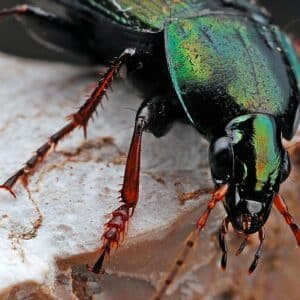
BEETLES
FUN FACT
Beetles have been around for about 270 million years, making them one of the oldest groups of insects. They have adapted to nearly every environment on Earth.
Schedule Your Hornet RemovalCall (512) 764-5804Identification
Beetles are one of the most diverse groups of insects, with thousands of species found across the United States. These small, hard-bodied insects can be found in various habitats, from forests and grasslands to urban areas. Beetles have a wide range of diets, including plants, fungi, and other insects, making them both beneficial and harmful, depending on the species.
Signs of Infestation
- Damage to Plants: Chewed leaves, stems, or flowers, particularly in gardens and crops.
- Presence of Larvae: Beetle larvae, often known as grubs, can be found in soil, feeding on plant roots.
- Frass: Accumulation of beetle excrement, known as frass, near infested areas.
- Boreholes: Small holes in wood or plants where beetles have burrowed.
- Beetle Sightings: Regular sightings of adult beetles in and around your property.
Breeding Season
Beetle breeding seasons vary by species but generally occur in warmer months. Female beetles lay eggs in suitable environments, such as soil, wood, or plant material. After hatching, larvae go through several stages of development before pupating and emerging as adults.
Ecosystem Role
Beetles play essential roles in the ecosystem, including:
- Pollination: Many beetle species are pollinators, contributing to plant reproduction.
- Decomposition: Beetles help break down organic matter, recycling nutrients back into the soil.
- Pest Control: Predatory beetles feed on harmful insects, helping to control pest populations.
- Food Source: Beetles are a vital food source for various animals, including birds, reptiles, and mammals.
Prevention Strategies
- Regular Inspections: Regularly inspect plants, wood, and soil for signs of beetle activity.
- Healthy Plants: Maintain healthy plants through proper watering, fertilization, and pruning to reduce vulnerability to beetle infestations.
- Natural Predators: Encourage natural predators, such as birds and beneficial insects, to help control beetle populations.
- Chemical Treatments: Use insecticides sparingly and follow instructions carefully to target specific beetle species.
- Cleanliness: Keep your property clean and free of debris, which can attract beetles.
Prickly Pear’s Approach
- Inspection: Thoroughly inspect your property to identify beetle species and signs of infestation.
- Exclusion: Implement barriers and strategies to prevent beetles from accessing plants and structures.
- Targeted Treatments: Use targeted treatments to address specific beetle infestations while minimizing impact on beneficial insects.
- Ongoing Monitoring: Regularly monitor beetle activity and adjust strategies as needed.
Conclusion
Beetles can be both beneficial and harmful, depending on the species and context. Prickly Pear offers professional services to manage beetle activity and protect your property. If you suspect a beetle problem, contact us for expert assistance in maintaining a balanced ecosystem and healthy plants.
